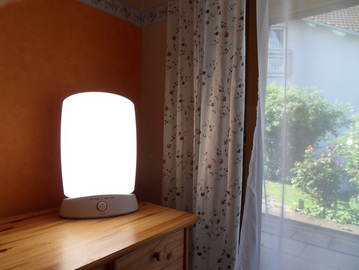 by Wei Perng, PhD For Christmas this year, I bought my parents a full-spectrum phototherapy lamp. As natives of Taiwan, an East Asian country with a subtropical climate and nearly year-round sunshine, my parents now suffer Seasonal Affective Disorder (SAD), aka the “winter blues,” due to Michigan’s long dreary winters. Although the idea of sitting in front of a light as an alternative to real sunshine seems strange to me, several of my friends and colleagues highly recommended a lamp to help relieve SAD symptoms. I figured, why not. My parents loved it. In fact, they were so enthusiastic that they bought one for me as well! Although I have not yet conjured up the self-discipline to put in my half-hour in front of the lamp every morning, I have been reading the book that came with it: Winter Blues: Everything You Need to Know to Beat Seasonal Affective Disorder by Norman E. Rosenthal, MD. I skimmed through the science behind how light therapy provides very specific types of illumination to the retina to influence hormones that regulate of sleep and mood patterns. What does this have to do with obesity and obesity prevention? Quite a bit, it turns out. How? Possibly through mechanisms that influence serotonin, melatonin, and glucose metabolism. Let’s go through each one.
Serotonin. Phototherapy may affect mood by stimulating serotonin, a neurotransmitter found in the gastrointestinal tract and central nervous system. Serotonin contributes to feelings of happiness and well-being, and levels are low in persons with depression or affective disorders. A deficit also may trigger cravings for high-carbohydrate, high-fat foods, which in turn will increase serotonin release via insulin secretion. By prompting serotonin release, phototherapy may ease these cravings and prevent excess consumption of unhealthy foods. Melatonin. Phototherapy may stop inappropriate secretion of melatonin, which is released during darkness and causes sleepiness. Inappropriate melatonin released in response to long periods of daytime darkness results in daytime lethargy could also cause poor sleep quality. As we saw from a previous blog post by Chelsea Jenter, poor sleep is a risk factor for obesity. By helping to regulate sleep, light therapy may promote a healthier weight. Glucose metabolism. Studies in rodents indicate that duration and timing of light exposure can actually affect weight gain, independently of caloric intake via glucose metabolism. Some evidence in humans also supports use of bright lights for weight loss. In a randomized trial, 34 overweight adult women - 10 of whom displayed SAD symptoms - were exposed to two different sessions: a 3-week session of morning phototherapy treatment and a 3-week session with a placebo light. What did the investigators find? As compared to the placebo, light therapy resulted in lower percentage body fat, fat mass, and appetite, with an average fat reduction of 0.35 kg. Interestingly, these differences were even more pronounced among participants with signs of SAD. Does this mean that light therapy is the next best weapon to combat the obesity pandemic? It’s certainly not a miracle answer. But light therapy does seem to help people with seasonal affective disorder, and early results suggest some benefit for weight loss, though it requires more careful investigation. Furthermore, we need to know more about whether light therapy can cause side effects; some consumers report headaches and eye/skin conditions that are not inconsequential. For now, fighting the winter blues and a growing waistline is best countered by keeping up on exercise and eating well. But, turning on the light may help too.
5 Comments
Susan Laubach
3/1/2015 10:09:54 pm
Dear Dr. Perng,
Reply
Wei Perng
3/2/2015 03:40:27 am
Susan, thank you so much for your comment. Winter weight gain could certainly be due the indoor sedentary behavior that goes hand-in-hand with cold weather. What is interesting is that persons with SAD report unexplained weight gain during the winter months that melts away ('seemingly effortlessly') as the days get longer, suggesting that some of the weight gain could be attributable to lack of sunlight. However, it's tricky to tease apart behavioral factors (e.g. feeling more motivated to exercise when the sun is out) from molecular mechanisms (e.g. changes in glucose metabolism) that operate independently of lifestyle. Hopefully, some careful, systematic research can untangle these relationships!
Reply
Sally Monsilovich
3/4/2015 04:43:08 am
Very interesting information as I have done some research on how lack of sleep can affect leptin and gherlin production, thus causing one to overeat possibly leading to obesity?? My question/concern is what kind of light is emitted through these phototherapy lamps? Is it harmful to the skin like UVA/UVB rays?
Reply
Wei Perng
3/5/2015 07:11:22 am
Sally, great question. Light boxes used to treat SAD are full-spectrum, meaning that they cover the electromagnetic spectrum from infrared to near-ultraviolet. However, the harmful UVA/UVB rays are filtered to avoid skin damage. One should still be careful about staring directly into the light to avoid cataracts, though!
Reply
4/7/2015 12:36:17 am
Because many of you asked me to review The Renegade Diet, I've ... help in resting an individual's digestive system
Reply
Your comment will be posted after it is approved.
Leave a Reply. |
©2017 WeighingInBlog. All rights reserved. 401 Park Drive, Boston, MA




 RSS Feed
RSS Feed

